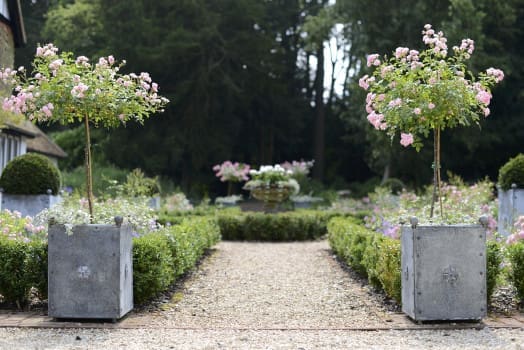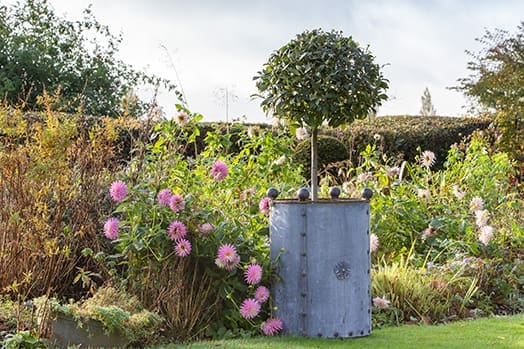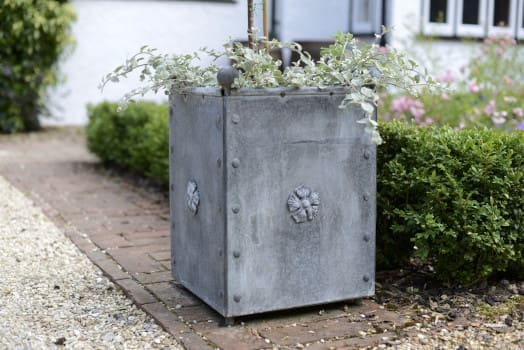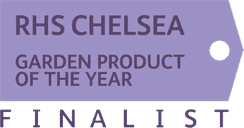
Growing a tree in a planter is a rewarding process that offers the pleasure of gardening without the need for expansive outdoor space. When you choose to raise a tree in a container, you’re committing to crafting a micro-environment that meets the specific needs of your chosen species. Despite the limited space, a tree can thrive in a planter as long as you provide the correct care and conditions.
Selecting the appropriate planter is the first step towards ensuring that your tree has a healthy start. The size and material of the planter are crucial factors that affect the growth of the tree. It should be large enough to accommodate the tree’s roots and have adequate drainage to prevent waterlogging, which can lead to root rot. In addition, the choice of soil plays a significant role in the tree’s health, as it needs to be well-draining yet capable of retaining sufficient moisture to sustain the tree.
Watering and nutrition are imperative to the development of your potted tree. Trees in planters will depend entirely on you for their water and nutrients, as they won’t have natural resources to draw from as they would in the ground. You’ll need to maintain a consistent watering schedule, adjusting for seasonal changes and the tree’s growth stage. Furthermore, regular feeding with the appropriate fertiliser will ensure your tree gets the necessary nutrients to promote robust growth.
Selecting Trees for Planters
When choosing trees to grow in planters, it is essential to select species that will thrive in contained environments and to consider the ultimate tree size for successful cultivation.
Suitable Species
Evergreens like Holly and Bay Trees are popular choices for year-round foliage. Fruit Trees, particularly dwarf varieties like certain Apple and Citrus Trees, adapt well to planters. Japanese Maples provide ornamental value with their delicate foliage, whereas Pom Pom trees offer a manicured aesthetic. For those who prefer Acid-loving Trees, selections such as Azaleas and certain Rhododendrons suitably adjust to container life.
- Evergreen Trees: Holly, Bay Tree, and Conifers.
- Fruit Trees: Compact varieties of Apple, Pear, Cherry, and Citrus Trees.
- Ornamental Trees: Japanese Maples, Pom Pom Trees, and small Acacia varieties.
- Acid-Loving Trees: Specific Azaleas and Rhododendrons.
Our round galvanised steel planter is a great aesthetic choice for Pom Pom style trees:

You can buy our round planter online here.
What is a deciduous tree?
Deciduous trees are a type of tree that shed their leaves annually, usually in response to the changing seasons. In contrast to evergreens, which retain their foliage year-round, deciduous trees typically lose their leaves in Autumn and remain bare throughout the winter.
What is the best time of year to plant a deciduous tree?
The best time of year to plant a deciduous tree is during its dormant season, which typically falls in late Autumn after leaf drop through to early spring before bud break. Planting during dormancy allows the tree to establish roots in its new location without the stress of supporting leaf growth, flowering, or fruiting.
In late fall, the soil is still warm from the summer, which encourages root growth, but the cooler air temperatures reduce the likelihood of stress on the new transplant. However, it’s important to plant the tree well before the ground freezes to give the roots time to settle if you are planting outside.
Early spring planting is also advantageous because the soil is beginning to warm up, which promotes root development. The tree will have the entire growing season to establish itself before the heat of the summer or the cold of the next winter.
Considerations for Tree Size
Assessing the mature size of the tree is critical. It influences the choice of planter size and the space allocated for root growth. For larger trees, extra large planters are necessary to accommodate the extensive root systems. Dwarf Varieties are more suited to modest-sized containers. Deciduous Trees can also be kept in planters but require vigilant care to simulate the natural conditions found in the ground.
- Container Size: Match the expected root size to a planter allowing ample room for growth.
Mature Tree Size Container Size Small 40-60 litres Medium 60-100 litres Large 100+ litres - Root Space: Ensure the planter provides adequate space for the tree’s roots to prevent girdling and root-bound conditions.
Remember, the larger the tree, the more substantial your planter should be. Giant planters complement trees that will reach a considerable mature size, offering both stability and space for root growth.
Planter Selection and Preparation
Choosing the right planter and properly preparing it are crucial steps in successfully growing a tree in a container. These initial actions set the stage for your tree’s health and growth.
Choosing the Right Planter
Selecting a planter that accommodates the growth of a tree involves consideration of size, material, and drainage. When selecting a large planter for a tree, consider opting for an extra large square planter or an extra large tree planter for outside to provide ample room for root development, ensuring a sturdy base to counteract top-heavy growth. For specific species like olive trees or bay trees, ensure the container is proportional to the tree’s mature size. Tall containers can be particularly stylish and are suitable for trees for containers such as trees for pots.
Planter Characteristics:
- Size: Choose a planter that can accommodate the tree’s root system. The rule of thumb is that the planter for a tree should be at least twice the width of the tree’s root ball.
- Material: Materials such as wood, metal, or heavy-duty plastic are commonly used. Each has its benefits – wood is aesthetically pleasing, metal is durable, and plastic is lightweight. However, terracotta, while attractive, may not withstand freezing temperatures.
- Drainage: Good drainage is essential. Look for planters with pre-drilled holes or plan to add them yourself.
Arthur Jack Planters
Our large and extra large galvanised steel planters are perfect for planting a tree in and come with pre-drilled holes for excellent drainage.

View our planter range in our online shop
Preparing the Planter
Before introducing your tree to its new home, ensure the planter is ready. Begin with a clean container to reduce the risk of disease or pests. Lay a layer of rocks or broken pottery over the drainage holes to prevent soil from washing out and promote water flow.
Planter Preparation Steps:
- Clean the planter using hot, soapy water and rinse well.
- Cover the drainage holes with a layer of gravel or pot shards.
- Now, fill the container with a mix of high-quality soil and soil improvers. A combination of fresh compost and specific soil mixes designed for potted trees can provide the necessary nutrients. For example, ericaceous compost is essential for acid-loving trees.
- Consider adding a layer of compost or organic matter at the top for additional nutrients.
- Finish with a protective layer of mulch to retain moisture and regulate soil temperature.
By following these guidelines, you will ensure your chosen container is an ideal environment for your tree to thrive.
Planting and Caring for Trees in Planters
For successful growth of trees in planters, key considerations include proper planting techniques, stability, regular watering, feeding, and maintenance adjusted for seasonal changes.
The Planting Process
To start, choose a container that is proportionate to the size of the tree you wish to grow, ensuring it has adequate drainage holes to prevent waterlogging. Select a high-quality potting mix that is appropriate for the tree species, as this will provide the necessary nutrients and support for healthy root growth.
Carefully remove the tree from its nursery pot, gently loosening any circling roots to encourage outward growth. Center the tree in the container and fill around it with potting mix, being careful not to bury the trunk deeper than it was originally grown. Water the tree thoroughly after planting to settle the soil and eliminate air pockets.
Container-grown trees, as well as bare-root trees, can be planted from autumn to spring. For bare-root trees, soak the roots in a bucket of water for a few hours before planting. Make sure the planter is large enough to accommodate the tree’s future growth; typically, it should be at least twice as wide and deep as the root ball.
- Planting steps:
- Fill the bottom of the planter with regular soil mixed with compost.
- Position the tree in the centre and fill around it with soil, ensuring the root crown is at soil level.
- Gently firm the soil to eliminate air pockets without compacting it too much.
Staking and Stability
Staking provides stability to newly planted trees, especially in windy conditions. To stake a tree in a planter:
- Insert a tree stake into the planter soil, beside the tree trunk but not damaging the roots.
- Use a soft tie to connect the stake and tree, allowing for some movement.
- Check the stakes regularly and loosen if the tree begins to outgrow them.
Watering and Feeding
Effective watering and feeding are crucial for potted trees such as lemon trees, which may not obtain enough nutrients from limited soil. Apply water when the top inch of soil feels dry. In larger containers, ensure watering reaches several inches deep to provide adequate moisture. Feed with a liquid feed designed for plants in containers every two weeks during the growing season.
- Moisture tips:
- Provide amounts of moisture that keep up with the higher evaporation rates in sunny locations.
- Reduce watering in cooler conditions and cold months due to decreased evaporation.
Maintenance Throughout the Seasons
Routine pruning helps maintain a beautiful tree and encourages healthful growth. Shorter trees often fare better in containers due to lower water and nutrient needs. During cold winters, protect the tree’s roots with organic mulch and move the planter to a sheltered spot if possible. Always make sure the planter has drainage holes to prevent soggy soil, which can harm the tree. Adjust care as soil and air temperatures dictate throughout the year.
Nutrition and Soil Health
When growing a tree in a planter, ensuring the right nutritional balance and soil health is paramount. Potting soil is crucial as it supports your tree’s roots and provides essential nutrients. For trees, well-draining and nutrient-rich potting mix is best. This typically consists of loam, compost, and either sand or perlite to aid drainage.
Fertilisation significantly impacts your tree’s growth. A balanced, slow-release fertiliser with an equal ratio of nitrogen (N), phosphorous (P), and potassium (K), often denoted as 10-10-10 or 20-20-20, is recommended for consistent nutrient provision.
A proper nutritional plan includes periodic soil testing to adjust fertiliser applications according to your tree’s specific needs. Over-fertilising can be as detrimental as under-fertilising, causing root burn and unbalanced growth.
Here, we summarise the key points for optimal soil health and nutrition:
- Soil Type: Choose a high-quality potting mix with good drainage.
- Fertiliser: Use a slow-release fertiliser with a balanced N-P-K ratio.
- Feeding Schedule: Apply fertiliser according to the product’s guidelines and your soil test results.
- Annual Replenishment: Refresh the top layer of soil annually to replenish organic matter that’s been depleted.
Remember, healthy soil equates to a robust and vibrant tree. Pay attention to these details to ensure your tree thrives in its planter.
Frequently Asked Questions
When growing trees in planters, it’s crucial you select appropriate species, understand their care requirements, and use suitable containers. These FAQS will guide you in making informed decisions.
What are the best species of trees to cultivate in containers within the UK?
The best species of trees to cultivate in containers in the UK include Japanese maples, Olive trees, Bay laurels, and dwarf fruit trees such as apples and pears. These species are well-adapted to the UK climate and can thrive in pots with proper care.
How does planting trees in pots differ from planting them in the ground?
Planting trees in pots requires more frequent watering and feeding compared to planting them in the ground. In pots, soil dries out faster and nutrients can be leached out with regular watering. Also, potted trees may need repotting or root pruning to prevent them from becoming root-bound.
What considerations should be made when choosing pots for screening trees?
When choosing pots for screening trees, consider the pot’s stability, durability, size, and drainage capabilities. Containers must be sturdy enough to support the tree’s growth and withstand weather conditions, while also allowing for proper drainage to prevent waterlogging.
How large should a planter be to accommodate a tree that will grow up to 6 feet tall?
A planter for a tree that will grow up to 6 feet tall should be proportionate to the tree’s mature width and root system, with a general guideline being at least 45-50 centimetres in depth and width to provide adequate space for root development and stability.
What are the pros and cons of constructing a planter around an existing tree?
Constructing a planter around an existing tree can add aesthetic value and protect the tree’s roots, but it can also lead to soil compaction and drainage issues if not done correctly. Ensure proper space and drainage are provided to avoid damaging the tree.

